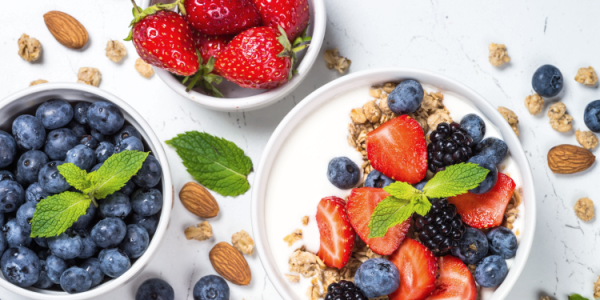
"Keto" has become quite the buzzword in and out of the health world.
But what actually does going keto entail? Are there true benefits from following a high-fat diet? And which foods are on and off-limits?
From keto risks, benefits, and diet rules, learn the truth of such a recognized (and often misunderstood) diet.
What Is a Keto Diet?
A ketogenic, or simply keto, diet is a high-fat, low-carb eating pattern intended to put the body in ketosis. Ketosis is a metabolic state in which the body uses ketones for energy. Generally, the body uses glucose as its primary fuel and energy source.
Being in ketosis requires compliance with a high-fat and low-carb diet. Low carbohydrates result in reduced blood sugar levels, which in turn breaks down fat for energy use. Fat is converted into fatty acids and ketone bodies by the liver, entering into a state known as ketosis.
How Many Carbs On Keto?
A standard ketogenic diet uses a ketogenic ratio - either 3 or 4 grams of fat for every 1 gram of carb and protein. This translates to upwards of 80 percent of daily calories coming from fat and 50 grams or less of carbs.
While all keto diets are high in fat and low in carbs, there are different versions of a ketogenic diet. These include the four most common types, including standard, targeted, cyclical, and high-protein ketogenic diets:
1. Standard Ketogenic Diet (SKD): You eat very low carbs (less than 50 grams of net carbs a day) every day. Some keto followers eat as few as 20 grams per day.
2. Targeted Ketogenic Diet (TKD): Similar to the SKD, though carb intake is targeted around exercise to provide fuel. The TKD may best benefit those with an active lifestyle.
3. Cyclical Ketogenic Diet (CKD): In the CDK, dieters eat 50 grams or less of carbs five to six days a week. On day seven, dieters have a carb refeed day (about 150 grams).
4. High-Protein Ketogenic Diet (HPKD): The HPDK follows the SKD but is more liberal in protein. (See below for a balanced high-protein ketogenic diet delivered to your door!)
With an increased need for fat in all versions, there is heavy use of butter, mayo, oils, and high-fat meats. But the keto diet is much more than slugging down copious amounts of butter. It includes keto-friendly (and not-so-friendly) foods.
Keto Diet Foods to Enjoy
On-limit keto diet foods mostly include sources laden in fat and moderate in protein.
Meat & Poultry
Animal meat and poultry are naturally low in carbohydrates. Sources to put into rotation include unbreaded products, such as bacon, chicken, ground beef, ham, pork, steak, and turkey. Choose grass-fed whenever possible, too.
It is important to remember, though, that keto is not a high-protein diet. Meat should not be consumed in excess and overall avoid eating too much protein.
Fish & Seafood
Fish and other seafood are devoid of carbohydrates and are excellent sources of healthy fats. Crab, halibut, lobster, mussels, salmon, shrimp, and tuna are just a few fish and seafood varieties to try.
Like meat and poultry products, avoid battered and breaded fish.
Fats & Oils
Notably, fats and oils are a foundation keto diet. Avocado oil, butter, coconut oil, lard, mayonnaise, and olive oil are common staples.
Non-Starchy Veggies
One cup of fresh or 1/2 cup of cooked, non-starchy veggies contains about 5 grams of carb. Adding them to a ketogenic diet plan is a great way to add fiber and micronutrients.
Example non-starchy veggies include asparagus, broccoli, cabbage, cauliflower, celery, cucumber, kale, lettuce, mushroom, onion, spaghetti squash, and spinach.
High-Fat Dairy
High-fat dairy products include cream cheese, heavy cream, soft and hard cheese, sour cream, and yogurt. Just watch out for added sugars in yogurt!
Eggs
Scrambled, poached, hardboiled… No matter how you crack it, eggs are rich in healthy fat and free of carbohydrates. They also contain the highest quality of protein money can buy.
The yolks are one of the very few food sources naturally supplying vitamin D as well.
Nuts, Seeds, & Related Butters
Nuts and seeds are rich in healthy fats. However, they should not be consumed in excess, as they still often contain some carbs.
Almonds, Brazil nuts, chia seeds, pecans, and walnuts are some of the few nuts and seeds enjoyed on a keto diet.
Low-Carb Fruits
Fruit is often rich in carbohydrates, though there are some that can fit into a keto diet. This especially serves true when moderating portion and serving sizes.
Avocado, blackberry, blueberry, raspberry, strawberry, and olives are often balanced in a high-fat diet.
Keto Diet Foods to Limit or Avoid
Limiting or avoiding moderate to high-carb foods is another focus of the keto diet. More specific examples include grains, beans, starchy veggies, fruits, and sweet treats.
Grains
Grains of all kinds are carb-rich, so stray away from their intake on a keto diet. Avoid barley, farro, millet, oats, peas, quinoa, rice, rye, and wheat. This also means cutting out products containing these grains, including bread, cereal, and pasta.
Beans & Legumes
Beans and legumes contain plant-based protein, but they are also rich in carbs. Limit or avoid lentils, soybeans, peas, peanuts, peanut butter, and bean varieties including black, kidney, and pinto.
Starchy Veggies
Unlike non-starchy veggies, starchy veggies are starchy vegetables that are higher in carbohydrates. Beets, butternut squash, carrots, corn, pumpkin, russet potatoes, sweet potatoes, pumpkin, and yams are examples.
Fruits
While there are fruits that can fit into a keto diet, most are considered off-limits. Higher carb fruits include apples, bananas, cherries, grapes, mangoes, pears, pineapples, and watermelon. Avoid all fruit juices, too.
Snacks & Sweets
Carb-rich snacks and sweets should be avoided, as they tend to be laden in carbs without nutritional benefits. Cut out chips, crackers, cake, candy, cookies, and any product with added sugar.
Potential Uses & Benefits of the Keto Diet
The ketogenic diet was coined in the early 1920s when Russel Wilder used it as a treatment for epilepsy. Hospitals took to the diet to manage epilepsy and seizures, primarily in the pediatric population. Epileptic adult patients who show no improvement through conventional methods have also benefited from the ketogenic diet.
Fast forward to modern-day, the ketogenic diet has exploded the worlds of diet, health, and science. Growing studies show keto may lead to many health benefits, including weight loss, heart health, and diabetes management. A keto diet may also reduce the risk of developing neurodegenerative diseases, including Alzheimer's and Parkinson's diseases.
Weight Loss
Weight loss can be complex, but dieters often turn to keto as a simple solution to lose body fat. A meta-analysis suggests a ketogenic diet can be more helpful for weight loss compared to low-fat diets.
Heart Health
Dyslipidemia, or abnormal lipids in the blood, is a well-known risk factor for heart/cardiovascular disease. Evidence suggests a keto diet plan may improve total cholesterol, HDL cholesterol, triglycerides, and LDL cholesterol levels. High blood pressure (BP) also increases heart disease risk, though data lacks on the significance of keto on BP.
Diabetes Management
People with diabetes are encouraged to manage blood sugars, especially by monitoring carb sourcing and intake. Some data shows a keto diet may be an effective alternative and preferable option, especially when medications are not available.
Age & Brain Support
Alzheimer's and Parkinson's diseases can occur prematurely, though they are most common in seniors. Research implies keto diet may play a role in reducing such risk or progression by protecting brain cells from damage.
Keto Risks to Consider
Though the benefits of a ketogenic diet are appealing, there are potential risks and side effects one should consider.
Especially when first beginning the ketogenic diet and transitioning into a state of ketosis, people may experience the "keto flu." The short-term reactions of following a keto diet may include the following:
• Brain fog
• Fatigue
• Dizziness
• Headaches
• Changes in bowel habits
• Leg cramps
• Bad breath
• Fluid and electrolyte imbalances
Proponents of the keto diet suggest drinking plenty of water and ensuring electrolyte intake can lessen these risks.
Beyond these initial side effects, following keto for a longer duration can be harmful and serious. Long-term adverse effects include:
• Hepatic steatosis (fatty liver)
• Hypoproteinemia (low levels of protein in the blood)
• Kidney stones
Further risks are related to nutritional deficiencies since cutting out a widespread of food groups and sources. For instance, avoiding whole grains and carbs can dramatically reduce the intake of fiber and beneficial nutrients proven to benefit health.
Some consequences of avoiding and reducing carbs may relate to digestive issues, cognitive dysfunction, and weight management. There are additional contraindications as well, including people managing blood sugars.
Digestive Issues
The fiber found in complex carbs promotes overall digestive health, including bowel regularity. Diets rich in fiber have also been shown to protect from diseases of the colon, hemorrhoids, and colorectal cancer.
Cognition Dysfunction
As mentioned, the brain uses carbs as fuel and if devoid of carbs, you might feel light-headed and irritable. It may be difficult to concentrate and focus, too.
Furthermore, the folate found in oats and other whole grains is crucial for proper brain development and function. Antioxidants and other vitamins and minerals supplied by complex carbs have been shown to be protective against dementia and Alzheimer's disease.
Yo-Yo Dieting
High-fiber foods are generally low in calories and tend to be more filling than non-fiber foods. The combination of low-calorie and satiety may facilitate weight loss and/or encourage weight maintenance.
Cutting carbs may likewise increase the risk of other weight concerns, including weight regain and chronic yo-yo dieting.
Additional Contraindications
Some populations, notably with certain disease states, should stray away from keto. Or, at least be monitored by a healthcare professional.
These include people managing diabetes and taking insulin or other medications to reduce blood sugars. Because if not cautious, severe hypoglycemia and even death are at risk. Other contraindications include those with liver failure, pancreatitis, and disorders of fat metabolism, just to name a few.
Ketogenic Diet: Yay or Nay?
All-in-all, a keto diet does can be beneficial for some people. However, the keto risks should also be considered.
For one, the keto diet is also vastly different from the Dietary Guidelines for Americans (DGAs) recommendations. The DGAs are created using the latest research that examines the relationships between chronic disease risks and eating patterns. The components of the recommended eating pattern can have interactive and potentially cumulative effects on health.
Specifically, the DGAs encourage consuming a healthy eating pattern that accounts for all foods and beverages within an appropriate calorie level. According to the DGAs, a healthy eating pattern includes:
• A variety of vegetables from all of the subgroups - dark green, red and orange, legumes, starchy, and other colorful varieties
• Fruits, especially whole fruits
• Grains, at least half of which are whole grains
• Fat-free or low-fat dairy, including milk, yogurt, cheese, and/or fortified soy beverages
• A variety of protein foods, including seafood, lean meats and poultry, eggs, legumes, nuts, seeds, and soy products
• Oils
A healthy eating pattern limits:
• Saturated fats and trans fats
• Added sugars
• Sodium in excess
That being said, instead of dropping carb intake or increasing them, balance the diet with lean proteins and healthy fats. Doing so is a surefire approach to ensure the body is receiving the nutrients it requires, along with promoting longevity.
Unlike the ketogenic diet that requires strict guidelines, bistroMD's Keto Flex program offers flexibility to best fit your health goals and lifestyle! Utilizing fresh ingredients, each meal is balanced with adequate lean protein, fiber, and healthy fat.
The Bottom Line
All-in-all, seek out professional help before giving in to the hype of keto, especially if managing a health condition. Most nutrition experts discourage cutting out food groups unless medically advised and supervised to do so.
Dietitians encourage balancing the diet with all food groups, including whole grains, fruits, vegetables, lean proteins, and healthy fats. What’s more, all can benefit from reducing overly processed foods rich in refined flour, sugar, oil, and salt. (But an occasional treat could and should certainly remain on the table!)
Eating a balanced, nutrient-rich diet can naturally lead to a healthy body weight and other benefits. And long-term weight loss results if a diet can be sustained, which is one common downfall of the keto diet. To top it off, losing weight is not guaranteed on a keto diet...







